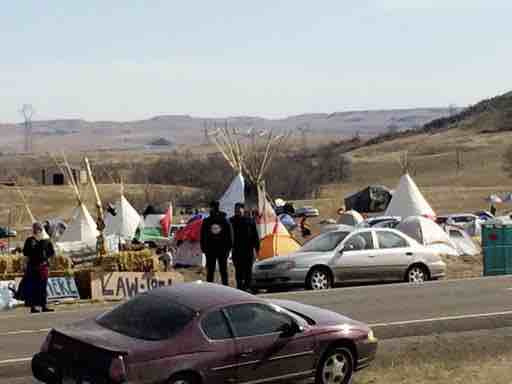Police Begin to Remove Oil Pipeline Protesters

CANNON BALL, N.D. (AP) — Armed law enforcement officers and soldiers, including some in riot gear, moved in on Thursday to remove Dakota Access pipeline protesters camped on private land in the path of the oil pipeline in North Dakota.
Authorities with trucks, police cars, military Humvees and buses began the operation just before midday, with sirens blaring and officials telling protesters over a loudspeaker to move out. Police were wearing riot gear, and many were armed. Two helicopters and a fixed-wing airplane monitored the operation from the air.
Protesters parked cars on the highway near the camp and slashed the vehicles’ tires to try to slow the authorities.
The forcible removal began a day after protesters refused to leave voluntarily.
Morton County Sheriff Kyle Kirchmeier said in a statement that the protesters’ actions “forced law enforcement to respond.”
“I can’t stress it enough, this is a public safety issue,” he said. “We cannot have protesters blocking county roads, blocking state highways or trespassing on private property.”
The months-long dispute over the four-state, $3.8 billion pipeline reached a crisis point when some 200 protesters set up camp on land owned by pipeline developer Energy Transfer Partners. The disputed area is just to the north of a more permanent and larger encampment on federally-owned land where hundreds of protesters have camped for months.
Law enforcement officials demanded that the protesters leave the private land on Wednesday, but they refused. Thick fog and cloudy skies on Wednesday appeared to stall the law enforcement effort, but the sun came out on Thursday with scattered clouds and a light breeze. Officials have frequently monitored protesters by air.
The Federal Aviation Administration is restricting flights over the Cannon Ball area until Nov. 5, allowing only aircraft affiliated with the North Dakota Tactical Operation Center and banning drones.
The activists fear the pipeline could harm cultural sites and drinking water for the Standing Rock Sioux tribe. The company and the state of North Dakota say no sensitive cultural sites have been found.
Protests supporting the Standing Rock Sioux have been ongoing for months, with more than 260 people arrested before Thursday’s operation.
The pipeline is to carry oil from western North Dakota through South Dakota and Iowa to an existing pipeline in Patoka, Illinois, where shippers can send it on to Midwest and Gulf Coast markets. Energy Transfer Partners has said the pipeline is nearly complete other than the work in south central North Dakota.
The protest has drawn the attention of activists and celebrities, including actress-activist Shailene Woodley and Green Party presidential candidate Jill Stein. Civil rights activist Jesse Jackson and actor Mark Ruffalo were at the protest camp Wednesday but departed later in the day.
Related News
Related News

- Keystone Oil Pipeline Resumes Operations After Temporary Shutdown
- Biden Administration Buys Oil for Emergency Reserve Above Target Price
- Freeport LNG Plant Runs Near Zero Consumption for Fifth Day
- Enbridge to Invest $500 Million in Pipeline Assets, Including Expansion of 850-Mile Gray Oak Pipeline
- Williams Delays Louisiana Pipeline Project Amid Dispute with Competitor Energy Transfer
- Evacuation Technologies to Reduce Methane Releases During Pigging
- Editor’s Notebook: Nord Stream’s $20 Billion Question
- Enbridge Receives Approval to Begin Service on Louisiana Venice Gas Pipeline Project
- Russian LNG Unfazed By U.S. Sanctions
- Biden Administration Buys Oil for Emergency Reserve Above Target Price




Comments